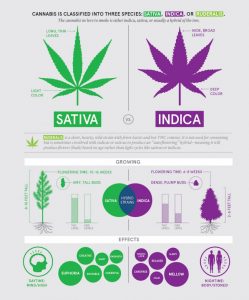What’s missing from Colorado Cannabis labels?
There are three important words missing from Colorado Marijuana labels, both medical and recreational. It’s so obvious, I can’t believe it is even an oversight of the law. What is the one thing everyone must be aware of before making a strain selection? Indica, sativa, or hybrid, right? In most cases dispensaries separate product by three categories – indica, sativa or hybrid. Unfortunately the container or label does NOT indicate strain type. Why is it important?

What’s the difference? First, there are huge differences in strain effects between indica and sativa. Indica is known as a sedative-like high and recommended if you want to relax, chill on the couch, or induce sleep. Sativa typically provides a more energetic and uplifting cerebral effect that pairs well with physical activity, social gatherings, and creative projects. Hybrids are a mix between indica-sativa strains, depending on characteristics inherit from the parent strains. For example, most hybrids indicate the percentage of indica vs sativa as part of the strain description, like 80/20 or 60/40.
What’s the problem? Now, once you get home, if you don’t remember which is the indica or which is sativa, you’re out of luck because that information is no where to be found on the container, label, or receipt. For medical patients this is a big deal. Similar to mixing up prescribed medications, not knowing if you’re consuming indica or sativa, could result in serious consequences.
What’s on the label? If you’ve ever reviewed the label required on purchased cannabis or cannabis products, you’ll find that cannabis firms are required by the state to add the following:
- The license number of the retail store, cultivation, or manufacturer;
- Batch Number(s) ;
- Strain name;
- Net weight,
- List of all non-organic pesticides, fungicides, and herbicides used during cultivation;
- Required Potency Statement that include THC and CBD percentage amounts;
- Required Contaminant Testing Statement;
- Statement regarding refrigeration;
- Expiration date;
- Universal Symbol for THC, which must be present on packing and product;
- Directly below the Universal Symbol: must read: “Contains Marijuana. For Medical Use Only. Keep out of the reach of children.”
- If an edible, must have a nutritional fact panel.
In addition, the following warnings are also required on package or label:
- “Contains Marijuana. For Medical Use Only. Keep out of the reach of children.”
- There may be health risks associated with the consumption of this product.”
- “This product contains marijuana and its potency was tested with an allowable plus or minus 15% variance pursuant to 12-43.3- 202(2.5)(a)(I)(E), C.R.S.” iii.
- “This product was produced without regulatory oversight for health, safety, or efficacy.”
- “There may be additional health risks associated with the consumption of this product for women who are pregnant, breastfeeding, or planning on becoming pregnant.
There is actually more, but I decided to stop here. If you want to see the complete ruling, read the Colorado Marijuana Regulations, particularly: R 1000 Series – Labeling, Packaging, and Product Safety. If you want to see what other states are doing, use Leafly, they’ve outlined each states law surrounding packaging and labeling.
The burden of strain identity is on the consumer, but should it be? As part of the state requirement, all of the above info is printed on a label affixed to an oversized prescription bottle. The font is NOT allowed to be smaller than 1/16 of an inch that is equivalent to about a 6 pt. font, which is extremely small and almost illegible for the consumer to read. In all of the required printed information on the container, label, and receipt, the absence of three critical words remain: indica, sativa, or hybrid. I find myself using a sharpie to add an “I”, “S”, or “H” to each container to identify when to use responsibly. However, there may be a few dispensaries out there who indicate the strain type on the label, if yours doesn’t, ask them to do if for you. Maybe strain type on the label should be a standard and not an oversight. What do you think, is indicating indica, sativa, or hybrid on the package important to you?
Please consume responsibly. Cannabis and cannabis products are for adults 21 years and older.
Peace, Love, and Cannabis,
Lori
Sources:
Colorado Marijuana Enforcement: https://www.colorado.gov/pacific/enforcement/laws-constitution-statutes-and-rules-marijuana-enforcement
Infographic: http://www.refinery29.com/difference-between-indica-and-sativa
Graphics: Pixabay.com




